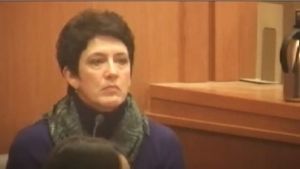

The Expert: Paula Cascio, an expert in nursing obstetrics, testifies for the defense and concludes the hospital staff met their standard of care.

Certified Nurse Midwife Paula Cascio testifies for the defense during a 2014 medical malpractice case in which the plaintiffs claim the defendant health care providers failed to perform a C-section in time, leading to an infant’s cerebral palsy.
The expert begins by stating flatly that the nurse midwife in question did meet the standard of care for nurse midwives in her treatment of the plaintiff and her baby. This is based upon the defendant’s monitoring of the mother’s vital signs, contractions, pain, and pitocin administration as well as the baby’s fetal heart rate monitor tracing (strip). She also explains that the charge nurses who had been included in the lawsuit, had no responsibility that would support their being included in this legal action.
Cascio explains that the accused midwife performed appropriately after accurately assessing the fetal heart monitor results. She repositioned the patient 16 times as recorded in the chart documentation, in an attempt to accomplish intrauterine resuscitation. These repositionings were in response to decelerations noted on the fetal monitoring strip. However, despite these indications of fetal distress, the labor proceeded from 1:00 AM to 9:30 AM without progression to a Category 3 heart monitor tracing. Such a category would indicate significant fetal compromise and the need to “move towards delivery.” The lack of such progression, Cascio found “reassuring.”
Variability in the strip tracing is the key component, and she read the strip as demonstrating moderate variability in the heart rate. This would indicate that the child was well oxygenated. At times during this period, she noted the strip to demonstrate recurrent variable decelerations. Variable decelerations are not unusual (present in 80%), but when they become recurrent, they can be indicative of umbilical cord compression. It is important to note, therefore, whether the variability is lost or absent or if there is a slow return to the baseline. These indications of a major problem were not present before 9:30 AM according to Cascio. As long as the recurrent variable decelerations contain moderate variability, the expert said, the baby is not in danger.
In contradiction to another expert’s testimony, Cascio affirms that this was not a “bad strip” and that the strip does not trend toward Category 3 because once the mother’s effacement was complete at 7:34 AM, the strip began demonstrating accelerations. These are times when the heart rate goes above baseline for about 15 beats and then returns to baseline. Accelerations are not necessary, but they indicate that the baby is being well oxygenated and has not become acidotic. The tracing in this case had nothing in it that would predict the fetal distress that would later occur. The moderate variability continued up to the second stage of labor when the effacement of the cervix became complete. Category 1 tracings occurring after that stage were again “completely reassuring” to Cascio. The recurring moderate variable decelerations had resolved and the tracing had improved after 7:34 AM when Stage 2 was established. Problems would not be noted until 2 hours later.
The testimony in this clip concludes with a discussion about intrauterine resuscitation. There are four key components of this: reposition the patient, provide hydration intravenously, give oxygen to the mother, and then inform the provider. The defendant met the standard of care with regard to intrauterine resuscitation according to this expert.
Her testimony was delivered in a calm, confident, clear voice and was easy for the jury to understand. She was extremely believable and the jury verdict for the defense may have hinged upon her presentation.
Gary Gansar, MD, is residency-trained in general surgery. He served as Chief of Surgery and Staff at Elmwood Medical Center and on the Medical Executive Committee at Touro Infirmary and Mercy Hospital in New Orleans, LA. Dr. Gansar was Board Certified in general surgery while in active practice. He joined AMFS in 2015 as a Physician Medical Director.
The medical expert witness partner for attorneys serious about building a winning case
AMFS is your trusted source for highly-qualified medical expert witnesses. After pioneering the field nearly three decades ago, we’re continuing to redefine medical expert witness services by providing value far beyond a referral alone.
Our Physician Medical Directors know what it takes to build a strong case. Our medical expert witnesses leave no doubt. And our case managers streamline billing and logistics every step of the way, letting you focus on what you do best: constructing your winning case. Explore why AMFS clients expect more from their medical expert witnesses—and get it.
